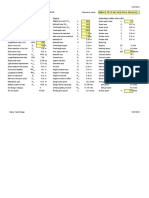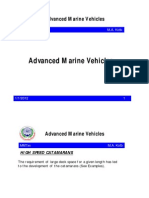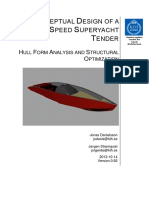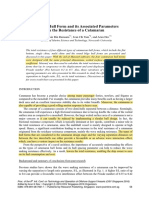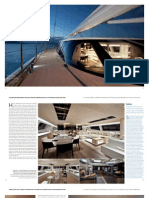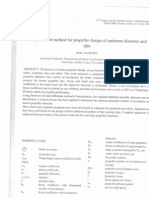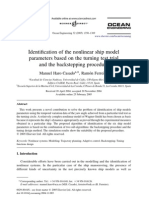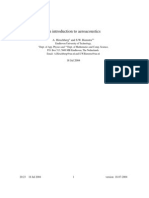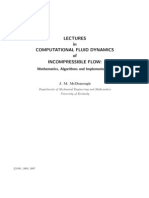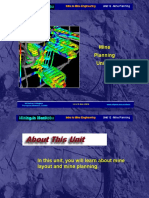Aerodynamic Analysis of Sailing Ship
Aerodynamic Analysis of Sailing Ship
Uploaded by
Gohar KhokharCopyright:
Available Formats
Aerodynamic Analysis of Sailing Ship
Aerodynamic Analysis of Sailing Ship
Uploaded by
Gohar KhokharOriginal Title
Copyright
Available Formats
Share this document
Did you find this document useful?
Is this content inappropriate?
Copyright:
Available Formats
Aerodynamic Analysis of Sailing Ship
Aerodynamic Analysis of Sailing Ship
Uploaded by
Gohar KhokharCopyright:
Available Formats
J Mar Sci Technol (2010) 15:230241 DOI 10.
1007/s00773-010-0088-8
ORIGINAL ARTICLE
Hydro- and aerodynamic analysis for the design of a sailing yacht
Wu-Joan Kim Jaehoon Yoo Zhengshou Chen Shin Hyung Rhee Hye-Ryoun Chi Haeseong Ahn
Received: 8 March 2009 / Accepted: 14 March 2010 / Published online: 17 April 2010 JASNAOE 2010
Abstract The results of the design analysis for a sailing yachts hull and sails are reported. The results were used to conrm the design of a 30 ft long sloop, which was planned, designed, and built in Korea for the rst time in history. Flows around a sailing yacht above and under the free surface were analyzed separately using both computational and experimental methods. For the underwater ow analysis, turbulent ow simulations with and without free surface wave effects were carried out for the canoe hull with keel/rudder. The computed drag and side forces on the hull model were compared with the measurement data obtained from the towing tank experiments. In order to assess the sail performance, another set of computations was carried out for the ow around a sail system composed of main and jib sails with a mast. The present study demonstrates that, for the design analysis of a sailing yacht, computational uid dynamics techniques can be utilized with a reasonable level of condence.
Keywords
Sailing yacht CFD Design analysis
1 Introduction Sailing yacht design is generally based upon empirical formulas and the designers experience, with the occasional use of model tests, such as towing tank experiments for the hull form and wind tunnel experiments for the sail design [1]. However, it is quite expensive to obtain useful hydro/ aerodynamic information from the model tests, because there are so many factors to be considered when attempting to predict the sailing yachts performance, such as the wind direction, advancing angle, interference between sails, heel and yaw angles, and the ow interaction between keel and rudder. Therefore, in addition to model tests, computational uid dynamics (CFD) is being widely adopted as an efcient tool for assessing ship performance, and is used extensively for the hydro/aerodynamic design analysis of sails, hull form, and appendages. There have been many reports on the use of CFD for sailing yacht design, including its application to state-of-the-art International Americas Cup Class (IACC) yachts [2, 3] and the boat motion on the free surface [4]. In order to support CFD simulations, selective towing tank experiments are also carried out to validate the CFD results. Although CFD is now a popular tool for sailing yacht design, physical model tests are still the most crucial part of the design process [5]. Flow analysis for a sailing yacht is much more complicated than that for a commercial ship, largely because of their different propulsion mechanisms. Sails can be considered a system of zero-thickness foils with an attack angle, and so they generate side forces as well as thrust. The so-called lateral resistance on the underwater portion of the hull and the keel/rudder should balance the side forces produced by
W.-J. Kim J. Yoo Z. Chen Department of Ocean Engineering, Mokpo National University, Jeonnam, Korea S. H. Rhee (&) Department of Naval Architecture and Ocean Engineering, Research Institute of Marine Systems Engineering, Seoul National University, Seoul, Korea e-mail: shr@snu.ac.kr H.-R. Chi Daewoo Shipbuilding and Marine Engineering Co., Ltd, Gyeongnam, Korea H. Ahn Maritime and Ocean Engineering Research Institute, Korea Ocean Research and Development Institute, Daejeon, Korea
123
J Mar Sci Technol (2010) 15:230241
231
the sails; otherwise the hull will drift. Therefore, a sailing yacht almost always advances with a leeway angle, i.e., the heading angle of the yacht centerline with respect to the advance direction. Sailing with this leeway angle results in an attack angle that leads to the production of side forces by the keel/rudder. Side forces from the sails and the keel/rudder also produce a coupling moment that acts as the heeling moment. The hull will then heel until this heeling moment is balanced by the righting moment due to buoyancy. A 30 ft long sloop was designed and built by the Maritime and Ocean Engineering Research Institute (MOERI). The present study is concerned with the hydro- and aerodynamic design analysis of the yacht, which was performed to conrm the newly developed design. In other words, the hull and sail design was analyzed and it was conrmed that the performance satises the desired velocity made good (VMG) results. Towing tank experiments were carried out in the MOERI towing tank to measure the hydrodynamic forces acting on the hull. Drag and side forces were measured in heeling and yawing conditions. Turbulent ow simulations around the hull and the sails were carried out separately using a CFD code that solves the Reynoldsaveraged NavierStokes (RANS) equations. For the underwater ow simulations, the canoe hull with the keel/ rudder was considered with and without free-surface wave effects. For the airow simulations, both main and jib sails were considered with the mast. The computational results were compared with the data from the towing tank experiments and the existing wind tunnel test data [6]. Better agreement with the towing tank experimental data is obtained when the free-surface wave effects are included. It was also conrmed that the heel angle has a large inuence on the hydrodynamic performance of a yacht hull. The ow eld around the main sail signicantly depends on the jib sail angle, since the main sail is placed in the wake of the jib sail. The calculated center of effort (i.e., the pressure center of the sail system) is much different from the geometrical center of the sail surface, although this is commonly employed as an empirical center of effort. The present paper is organized as follows. The geometry of the designed hull and sails is presented next. Then the experimental and computational methods are described, followed by the ow analysis results for the underwater and air ows around the hull and sails, respectively. We then make some concluding remarks.
along with empirical formulas for sailing yachts [7]. Since it was the rst sailing yacht designed in Korea, various requirements were imposed: an affordable yet multipurpose sailing yacht that incorporates state-of-the-art technology was required. The new designs parent ship was the Mini 6.5, introduced at the Madrid Diseno De Yates 04, which is smaller than the KORDY30s required size. For the desired size range, three reference ships were selected: Columbia 30, Auklet 9, and Yamaha 31 S. Details for the parent ship and the reference ships are available in Yoo et al. [7], as well as on the internet. The new design has a round-bottomed canoe hull with a long keel and a rudder. Figure 1 shows an artists rendering of the complete KORDY30. The principal particulars are given in Table 1. For the towing tank experiments, a model hull with a scale ratio (k) of 1/3 was manufactured. All of the measurements and simulated ows around the yachts hull were conducted on the model scale. 2.2 Main and jib sails The KORDY30 was equipped with a sloop sail system consisting of a main sail and a jib sail, as shown in Fig. 2. The sections of the main and jib sails were shaped as the NACA a = 0.8 mean camber line without thickness. Note that this shape is quite close to that of modern cloth sails. The luffs (i.e., the leading edges) of both the main and jib sails were xed; however, because of the wind load, the leeches (i.e., the trailing edges) had to be adjusted, except
2 Designed hull and sails 2.1 Hull The 30 ft long sloop, named KORDY30, was designed using traditional ship design methods for commercial ships
Fig. 1 Artists rendering of KORDY30
123
232 Table 1 Principal particulars of the KORDY30 Value LOA (m) LWL (m) B (m) Tc (m) T (m) r (m3) Wetted surface area (m2) 9.142 8.245 3.024 0.400 1.900 3.298 15.60 2.84 1.18 Denition Length overall Waterline length Beam (max.) Draft w/o keel Draft with keel Displacement Hull Keel Rudder
J Mar Sci Technol (2010) 15:230241
Fig. 3 Geometry of the main sail
Table 2 Geometrical parameters of the main sail Location Height (mm) Chord length (mm) Angle () Camber ratio Foot 0 4000 0 8 25% 3000 3000 5 10 50% 6000 2000 10 12 75% 9000 1000 15 14
2
Top 11900 10 20 16
P = 11.9 m, E = 4.0 m, area of main sail AM = 24.0 m
Table 3 Geometrical parameters of the jib sail Location Height (mm) Chord length (mm) Angle () Camber ratio Foot 0 C1 U0 8 25% 2750 75% C1 1.25 U0 10 50% 5500 50% C1 1.5 U0 12 75% 8250 25% C1 1.75 U0 14 Top 11000 10 2.0 U0 16
C1 = C09(1 ? overlap length) (mm), C0: length of jib sail foot 3900 mm, U0: baseline angle of jib sail foot (jib angle)
Fig. 2 Sloop sail system
Fig. 4. The jib sails leech overlapped with the main sails luff near the foot, and this overlap length is an important parameter that determines the interference between the two sails. The baseline angle of the jib sail, called the jib angle, was also a key parameter, since it determines the relative angle of the wind into the jib sail and the inow (i.e., the wake of the jib sail) into the main sail.
at the foot end of the main sail, as shown in Fig. 3. Figure 3 shows the typical sail shape under close-hauled conditions. The baseline angle of the main sail was varied as 0, 5, 10, 15, and 20 at 0, 25, 50, 70, and 100% of the height, respectively. The camber of the main sail at each height is given in Table 2. The geometrical parameters and shape of the jib sail under close-hauled conditions are given in Table 3 and
3 Experimental method 3.1 Towing tank tests The experiments were carried out in the towing tank of the Korea Ocean Research and Development Institute. The tank dimensions were 200 m (long) 9 16 m (wide) 9 7 m
123
J Mar Sci Technol (2010) 15:230241
233
Fig. 6 Directions of the forces exerted on the yacht hull Fig. 4 Geometry of the jib sail
Fig. 5 Towing system
(deep), and the maximum towing speed was 6 m/s. The model scale ratio for the towing model was set to 1/3, considering the towing speed and the load cell capacity. The model was manufactured from wood, with the rudder and keel attached. The keel was manufactured to be removable, thus allowing investigations of the hydrodynamic performances of the canoe hull with and without the keel. A special clamping device (Fig. 5) was prepared that is able to rotate with the load cell and x the model hull with heel and yaw. The load cell was attached at the location of the mast. While the model hull was towed at the predened xed attitude, the longitudinal (Fx) and transverse (Fy) forces were measured and converted to drag and side forces, as shown in Fig. 6. When the model was forced to heel, in order to investigate the hydrodynamic performance under heeling conditions, the displacement changed. Under
heeling conditions, therefore, the draft was rst adjusted in order to make the displacement the same as that when the model was not heeling, and then the force measurements were made. Further details of the towing tank tests are reported in Yoo and Ahn [8]. When a sailing yacht advances in the wind, it heels and yaws, and the direction of the sails strongly depends on the wind direction. As such, the hull attitude and the wind conditions should be dened at each speed. In the present study, the Designer Version 2004 of the Offshore Racing Congress (ORC) Velocity Prediction Program (VPP) was used to obtain the design conditions, and the towing conditions were determined, with the optimum point upwind considered to be the maximum VMG, and that downwind considered to be the minimum VMG. The optimum running attitude was also obtained based on the VPP results. The model ship was towed with Froudes corresponding speed; i.e., the ratio of the speed of the full-scale ship to that of the model hull was the square root of the model scale ratio (k1/2). The design speed of the full-scale yacht was 3.34 m/s (= 6.5 knots), and so the speed of the model hull was set to 1.93 m/s. The corresponding Reynolds number (Re) based on the model hull length was 5.86 million, and the Froude number (Fr) was 0.372. The design leeway and heel angles used in the tests were 3 and 20, respectively. The towing tests were conducted with varying heel angles at a leeway angle of 3, and with varying leeway angles at a heel angle of 20 (see Table 4). 3.2 Wind tunnel tests The experiments were carried out in the wind tunnel of the Chungnam National University of Korea. The test section dimensions were 5.2 m 9 1.8 m 9 1.8 m, and the wind speed was set to 45 m/s at maximum. The sail model was
123
234 Table 4 Experimental conditions for towing tank tests Value Model scale Model length Heel variation 0, 10, 20, 30 Leeway variation 0, 1, 2, 3 With keel/rudder 3.0 3.047 m With keel/rudder Denition LS/LM (LOA)M Vs = 6.5 knots Leeway = 3 Vs = 6.5 knots Heel = 20
J Mar Sci Technol (2010) 15:230241
Fig. 8 Unstructured grids around the yacht hull and appendages
Fig. 7 Wind tunnel experimental setup for sails
made of berglass-reinforced plastics (FRP), had a scale ratio of 1/9, and incorporated some rigging, such as a boom, side shrouds, and fore and after stays. Figure 7 shows the equipped model sails in the wind tunnel. A three-component load cell was installed under the sail model with a deck-sized at plate. The experiments were carried out for a wind speed of 10 m/s. A more detailed description of the experimental study is available in Yoo and Kim [6].
Computations were rst performed for turbulent ows around the canoe hull and appendages (i.e., keel and rudder). Unstructured grids with as many as 1.1 million cells were used for ows around the hull and appendages with and without free-surface wave effects, as shown in Fig. 8. Next, grids of 1.5 million cells were used for ows around the main and jib sails along with the mast. Figures 9 and 10 show the representative features of the grids. Although it is desirable to simulate the ows around the yacht hull and sails at the same time as the free surface waves, the ows around the hull and sails were analyzed separately in the present study. This is mainly to simplify the analyses and to better focus on the separate information needed for the hull and sail designs. 4.2 Computational conditions The computational conditions were the same as the experimental conditions. For the ows around the yacht hull, the free surface was rst treated as a symmetry plane (i.e., no wave effects were considered). The volume of uid (VOF) method was then used for the simulations with freesurface wave effects. It should be noted that the near-eld free-surface waves were of primary interest here, due partly to the limited scope of the present study and the computer resources available. In order to meet the constant displacement requirement with heel angles, the grid was rotated rst, and then the drafts on the port and starboard sides were adjusted until the calculated displacement reached the initial even-keel condition displacement. Table 5 provides the resulting drafts on the port and starboard sides, and Fig. 11 shows the heeled hull shapes. The abovementioned method of
4 Computational methods and conditions 4.1 Grid generation and ow solver Multiblock structured/unstructured grids were generated using the commercial grid generation package GRIDGEN. The CFD codes employed for the present study were the commercial codes FLUENT 6.2 and CFX 12. Both codes solve the RANS equations with second-order-accurate discretization schemes. For turbulence closure, the standard ke model was adopted with a wall function for FLUENT 6.2, while CFX 12 employs the kx SST model. Note that FLUENT 6.2 was used for the hydrodynamic analysis, and CFX 12 was used for the aerodynamic analysis.
123
J Mar Sci Technol (2010) 15:230241
235 Table 5 Wetted surface area and drafts at various heel angles (model scale) Heel 0 10 20 30 Wetted surface (m2) 2.1501 2.0911 2.0669 1.9637 Starboard Ts (cm) 13.000 19.706 26.577 29.126 Port Tp (cm) 13.000 6.148 2.094 0.030
Fig. 11 Hull shapes and drafts at various heel angles
Fig. 9 Surface grids on the main and jib sails with mast
Table 6 Computational conditions for ow simulation around sails Case 1 2 3 Overlap % of E 20 Jib angle U0 () 5 10 15
Fig. 10 Field grids around sails (view at a constant height)
The deck of the yacht was considered a symmetry plane, and a at plate was used for it in the wind tunnel tests. This is another reason why the hull and sail were treated separately in the present study. Table 6 summarizes the test conditions for ows around sails. The overlap length between the main and jib sails was set to 20% of the main sail foot length, while the baseline angle of the jib sail foot was changed. The lift and drag of the sails were normalized to the wind speed and the sum of the one-side areas of the main and jib sails.
determining the drafts under heeling conditions can be used for the hull form design as well. The sail shape varies when the wind blows because the rig and mast are deformed. The wind direction changes when the yacht is heeled. Furthermore, the viscous boundary layer on the sea surface certainly modies the inow velocity prole. However, in the present study, constant air inow was considered with an attack angle of 20 and a wind speed of 10 m/s. Note that this is based on the previous wind tunnel tests by Yoo and Kim [6].
5 Flows around a yacht hull As mentioned in the Introduction, the side forces on the sails balance the lateral resistance on the underwater portion of the canoe hull and the keel/rudder, while the coupling moment generated by these forces above and under the free surface makes the hull heel until it reaches equilibrium through buoyancy. When the hull heels, there is an
123
236 Fig. 12 Pressure contours at a leeway angle of 3 (heel angle 0)
J Mar Sci Technol (2010) 15:230241
Fig. 13 Pressure contours at a leeway angle of 3 (heel angle 30)
asymmetry in the ow eld [9], and the inow into the keel differs from that of the symmetric condition without heeling. The ow into the rudder is also inuenced by the wake of the keel. The computed surface pressure contours on the hull surface are shown in Figs. 12 and 13 for a leeway angle of 3 combined with heel angles of 0 and 30, respectively. When the yacht hull is heeling, the ow eld near the hull is also altered, which results in less lateral resistance on the keel/rudder. The rudder area under the free surface is also reduced, resulting in a further decrease in the lifting force produced by the rudder. As mentioned earlier, a heeled sailing yacht sails with a leeway angle to maintain balance. The yacht examined in the present study was designed to cruise with a heel angle of 20 and a leeway angle of 3. Changing the leeway angle
alters the lift force produced by the keel/rudder, which is conrmed by the surface pressure contours computed for a constant heel angle of 20 with various leeway angles (Figs. 14, 15, 16, 17). The pressure difference between the two sides of the keel/rudder increases with leeway angle, so the lift force by the keel/rudder increases. Obviously a sailing yacht generates waves when sailing on a real sea. Free-surface wave effects should be included to simulate the ow eld correctly. However, it is quite costly to simulate the ow around a yacht including freesurface wave effects (i.e., ne grids and high-performance computing are required). In the present study, as mentioned above, only the near-eld free-surface waves were considered. Figure 18 shows a comparison of the waterlines of the rigid free-surface plane condition (dashed lines) and the nal equilibrium free-surface condition (solid lines). The
123
J Mar Sci Technol (2010) 15:230241 Fig. 14 Pressure contours at a heel angle of 20 (leeway 0)
237
Fig. 15 Pressure contours at a heel angle of 20 (leeway 1)
dashed lines represent the waterlines used under symmetry plane conditions, which was applied for the simulations performed without free-surface wave effects. On the other hand, the solid lines show the nal free-surface shape obtained from the simulations that included free-surface wave effects using the VOF method. Note that, in the present study, the yacht hull was heeled to the starboard side, and the above gures are drawn as seen from the bottom. In the case of a heel angle of 0, the free surface near the stern region is raised. As the heel angle increases, the waterline is no longer symmetric and changes more dramatically. These waterline changes also alter the ow eld around the hull and the submerged shape of the rudder. The resulting drag and side forces when free-surface wave effects are included are different from those for the rigid free-surface plane condition. The drag and side forces for a leeway angle of 3 with various heel angles are shown in Fig. 19. It was observed
experimentally that the drag reaches its minimum at a heel angle of 20. When free-surface wave effects are not considered, the drag computed for the same heel angle is quite different from the measured drag, while the results obtained when free-surface wave effects are included generally agree with the measured ones. The side forces obtained under rigid free-surface plane conditions also show the opposite tendency to their experimental counterparts, because the elevation of the wave alters the wetted surface and the submerged area of the rudder. It was conrmed that free-surface wave effects play an important role in predicting the correct drag and side force when CFD is applied to evaluate yacht hull performance and balance. The drag and side forces for the heel angle of 20 with various leeway angles are shown in Fig. 20. Again, when the free surface wave effects are included in the CFD simulations, it is seen that better agreement is obtained with the experimental data, although they are still over-predicted.
123
238 Fig. 16 Pressure contours at a heel angle of 20 (leeway 2)
J Mar Sci Technol (2010) 15:230241
Fig. 17 Pressure contours at a heel angle of 20 (leeway 3)
Fig. 18 Waterline shapes at a leeway angle of 3: solid lines for with free-surface wave effects; dashed lines for the rigid free surface plane condition)
6 Flows around yacht sails Turbulent ows around the main and jib sails were simulated, and the results were compared with wind tunnel test
data [6]. The pressure distribution on the sail surface is displayed for jib angles of 5, 10, and 15 with an overlap length of 20% in Fig. 21. The limiting streamlines on the sail surfaces are also shown in Fig. 22. The wind direction
123
J Mar Sci Technol (2010) 15:230241
239
was 20 with respect to the baseline of the main sail foot. As the jib angle increases, the relative angle of attack for the jib sail decreases. On the windward side, the pressure is higher with a smaller jib angle, since the wind directly hits the jib sail rst. However, the main sail shows an opposite tendency, as it is located behind the jib sail (i.e., in the wake of the jib sail). The pressure contours on the leeward side are more dramatic. Flow separation on the jib sail surface is expected at a jib angle of 5, since the relative angle of attack reaches the stall angle of about 15, and so the interference between the jib and main sails becomes more complex. Therefore, it is recommended that the lift of the whole sail system (the jib and main sails) should be considered as one (i.e., the total contribution from the two sails). When the jib angle is 5, the limiting streamlines on the windward side are straight, while ow separation is observed on the leeward side. On the windward side of the main sail, the ow separated from the jib sail leech attaches and divides. For jib angles of 10 and 15, the limiting streamlines on the
Fig. 19 Drag and side forces with varying heel angles (leeway angle of 3)
Fig. 20 Drag and side forces with varying leeway angles (heel angle of 20)
Fig. 21 Pressure contours on the sail surface: left (leeward side); right (windward side). a Jib angle of 5 (case 1), b jib angle of 10 (case 2), c jib angle of 15 (case 3)
123
240
J Mar Sci Technol (2010) 15:230241
leeward side are similar, since the relative angle of attack is reduced, indicating that the existence of the main sail also affects the ow around the jib sail. The distance between the two sails is also an important factor in predicting the sail system performance. It is obvious that the interaction between the jib and the main sails should be considered carefully when evaluating the sail system performance. The computed drag and lift coefcients were compared with the experimental data [6], as summarized in Table 7. The computed results compare well with the experimental data. When the jib angle is 5, the jib sail produces more drag than the main sail, while the opposite is true at larger jib angles. This is because the ow separation around the jib sail is severe at a jib angle of 5, and this separated wake ow has a signicant impact on the inow into the main sail. As the jib angle increases, the ow pattern becomes more streamlined and the drag force decreases. It is observed that the total lift reaches its maximum value when the jib angle is 10, where the jib sail produces 70% of the total lift. Figure 23 shows the streamlines around the sails in cross-section at 25% of the sails height from the bottom, which agree with the tendency discussed above. The pressure center of the sail system, i.e., the center of effort (CE), is generally obtained from simple geometric considerations. Larsson and Eliasson [1] suggested that the geometric center of each sail should be taken as the center of effort, and the CE of the whole sail system should be considered the weighted geometric center of the sails in the system. This approach assumes that the pressure on the sail surface is constant throughout the whole system. In the present study, the CE of the sail system is calculated based on the computed pressure values for the sail system, as presented in Table 8. The calculated CE is indeed considerably different from the one obtained by the empirical formula using simple geometrical considerations, indicating that the CE calculation should be done more carefully, even during early design phases.
7 Concluding remarks The results of the design analysis for a sailing yachts hull and sails are reported. The results were used in the design
Table 7 Drag and lift coefcientsCFD results versus experimental data Jib angle () CFD (present) CL 5 Fig. 22 Limiting streamlines on the sail surface: left (leeward side); right (windward side). a Jib angle of 5 (case 1), b jib angle of 10 (case 2), c jib angle of 15 (case 3) 10 15 1.10 1.31 1.07 CD 0.25 0.19 0.13 Experimental data [6] CL 1.39 1.43 1.40 CD 0.37 0.30 0.25
123
J Mar Sci Technol (2010) 15:230241
241 Table 8 Location of the center of effort (CE) at a jib angle of 10 Location of CE Longitudinal Vertical Present -321.6 3428.5 Empirical formula [1] -130.9 3312.7
CE: location based on main sail tag Coordinates positive to stern, to top (mm)
experimental data. The overall agreement is fairly commendable, but the results computed without the free surface wave effects show a signicant deciency in predicting the drag under the design conditions. The computed results for the sail system were compared with existing experimental data [6]. It was found that the jib angle is a key parameter, since the ow interaction between the jib and the main sail depends on it. Furthermore, the jib sail generates more lift force than the main sail. It is also found that the CE estimated from the geometric center was quite different from the CE calculated from the computed pressure distribution.
Acknowledgments The present study was supported by the Ministry of Knowledge Economy (MKE) through the Regional Innovation Center and by the Ministry of Education, Science and Technology (MEST) through NRF Grant No. 2009-0087863. The fourth author was separately supported by MEST through a World Class University project (R32-10161) and the Multi-phenomena CFD Research Center (NRF Grant No. 2009-0083510).
References
1. Larsson L, Eliasson RE (2000) Principles of yacht design, 2nd edn. International Marine, Camden 2. Rosen BS, Laiosa JP, Davis WH Jr. (2000) CFD design studies for Americas Cup 2000 (AIAA Paper 2000-4339). In: Proc 18th AIAA Applied Aerodynamics Conf and Exhibit, Denver, CO, 14 17 August 2000 3. Akimoto H, Miyata H (2002) Finite-volume simulation method to predict the performance of a sailing boat. J Mar Sci Technol 17(1):3142 4. Jasak H (2009) OpenFOAM: open source CFD in research and industry. Int J Nav Archit Ocean Eng 1(2):8994 5. DeBord F Jr, Reichel J, Rosen B, Fassardi C (2002) Design optimization for the International Americas Cup Class. In: Trans SNAME Annual Meeting, Boston, MA, 2528 September 2002 6. Yoo JH, Kim HT (2006) Computational and experimental study on performance of sails of a yacht. Ocean Eng 33(10):13221342 7. Yoo JH, Van SH, Ahn HS, Kim J, Kim SH (2005) Development of 30 feet sailing yacht and performance predictions. J Soc Nav Archit Korea 42(1):3442 (in Korean) 8. Yoo JH, Ahn HS (2005) Experimental study on the hydrodynamic forces of 30 feet sailing yacht. J Soc Nav Archit Korea 42(3):233 240 (in Korean) 9. Yang J, Rhee SH, Kim H (2009) Propulsive performance of a tanker full form in damaged conditions. Ocean Eng 36(2):133144
Fig. 23 Streamlines around the sails at 25% of the sails height from the bottom. a Jib angle of 5, b jib angle of 10, c jib angle of 15
of a 30 ft long sloop, which was planned, designed, and built in Korea for the rst time in history. The ows around a sailing yacht hull with keel/rudder and a sail system consisting of the main and jib sails were studied. The forces acting on the yacht hull with various yaw and heel angles were measured in the MOERI towing tank. For the turbulent ow simulations, the RANS equations were solved with the standard ke model for turbulence closure. The VOF method was employed in the CFD code in order to include free-surface wave effects. The computed results for the hull with appendages were compared with
123
You might also like
- 4 Days 3 Nights Diy Bangkok Itinerary Travel GuideDocument5 pages4 Days 3 Nights Diy Bangkok Itinerary Travel GuidePinoy Adventurista100% (6)
- A.Nazarov - Power Catamarans - Design For PerformanceDocument11 pagesA.Nazarov - Power Catamarans - Design For PerformanceVlad100% (3)
- An Explanation of Sail Flow AnalysisDocument10 pagesAn Explanation of Sail Flow Analysiskaltne23100% (1)
- Hydrofoil Ship Design - W NeillDocument46 pagesHydrofoil Ship Design - W NeillGölfried GeorgeNo ratings yet
- Kormilitsin and Khalizev - The Theory of Submarine Design - 2001Document334 pagesKormilitsin and Khalizev - The Theory of Submarine Design - 2001Boris JorgenNo ratings yet
- The Aero-Hydrodynamics of Sailing Yachts Upwind in Waves PDFDocument174 pagesThe Aero-Hydrodynamics of Sailing Yachts Upwind in Waves PDFartnur0% (1)
- Ad Astra TrimaranDocument28 pagesAd Astra TrimaranAhmed BelalNo ratings yet
- Squat Effects: A Practical Guide To Its Nature, Measurement and PredictionDocument9 pagesSquat Effects: A Practical Guide To Its Nature, Measurement and Predictionwaleed yehiaNo ratings yet
- A.Nazarov - Small Patrol Boats - SelfRightingDocument9 pagesA.Nazarov - Small Patrol Boats - SelfRightingVladNo ratings yet
- Geometry of Ships - LetcherDocument95 pagesGeometry of Ships - LetcherSven Klinkhamer100% (12)
- Design of Bulk CarrierDocument7 pagesDesign of Bulk CarrierhoangductuanNo ratings yet
- FinalDocument17 pagesFinalTonyNo ratings yet
- ST7Document4 pagesST7marcelonieto761No ratings yet
- Heel Leeway On Resistance and SideforceDocument10 pagesHeel Leeway On Resistance and SideforceklzsailingNo ratings yet
- 2D Sail AerodynamicsDocument62 pages2D Sail AerodynamicsAbhipray JainNo ratings yet
- Savitsky - On The Subject of High Speed MonohullsDocument44 pagesSavitsky - On The Subject of High Speed MonohullssearchileNo ratings yet
- Hydrofoil CraftDocument9 pagesHydrofoil CraftAnonymous e3ceN15100% (1)
- SESS 6066: Sailing Yacht and Powercraft DesignDocument6 pagesSESS 6066: Sailing Yacht and Powercraft DesignIan RidzuanNo ratings yet
- Catamaran ParametersDocument3 pagesCatamaran ParametersMetin Mehel100% (2)
- Inverted Delta Wig Effect Aircraft 1Document92 pagesInverted Delta Wig Effect Aircraft 1xxxguysNo ratings yet
- The AD-1: "Oblique Wing Research Aircraft"Document4 pagesThe AD-1: "Oblique Wing Research Aircraft"NASAdocumentsNo ratings yet
- Hull Form Twin Skeg OptimizationDocument13 pagesHull Form Twin Skeg OptimizationLuis Angel ZorrillaNo ratings yet
- Hydrofoils and HovercraftsDocument23 pagesHydrofoils and HovercraftsPRAVEEN DEVRANo ratings yet
- Advanced Marine Vehicles Mm7xx 2009 2010 Lecture 4Document25 pagesAdvanced Marine Vehicles Mm7xx 2009 2010 Lecture 4Mohamed Abbas KotbNo ratings yet
- Planing Vessels 1Document13 pagesPlaning Vessels 1Ahmet GelisliNo ratings yet
- Yacht DesignDocument71 pagesYacht DesignMocanuRadu50% (2)
- Hydroptere - FoilsDocument9 pagesHydroptere - FoilsMaurizio BernasconiNo ratings yet
- Hydrodynamic Analysis Techniques For High-Speed Planing Hulls-Reza YousefiDocument9 pagesHydrodynamic Analysis Techniques For High-Speed Planing Hulls-Reza YousefiFernandocf90No ratings yet
- The Yacht Design ProcessDocument11 pagesThe Yacht Design ProcessTomislav TomoNo ratings yet
- Ucl 2016Document305 pagesUcl 2016sawan rajainNo ratings yet
- Design of Hydrofoil UsingDocument18 pagesDesign of Hydrofoil Usingmarihomenon100% (1)
- Stability of MultihullsDocument11 pagesStability of MultihullsnecatiygtNo ratings yet
- (Catamaran) Effect of Hull Form and Its Associated Parameters On The Resistance of A Catamaran - MaxsurfDocument11 pages(Catamaran) Effect of Hull Form and Its Associated Parameters On The Resistance of A Catamaran - MaxsurfWm Erick Cr100% (1)
- Membranes and SailsDocument27 pagesMembranes and SailsgoharmahmoodkhokharNo ratings yet
- Hull Form DesignDocument32 pagesHull Form DesignJoseph PrafulNo ratings yet
- 342546Document336 pages342546y_596688032No ratings yet
- Planing Craft: The Editor Dr. Daniel SavitskyDocument29 pagesPlaning Craft: The Editor Dr. Daniel SavitskyAkbar Adi WijayaNo ratings yet
- Carbon Fabric Composites Training Course 2020 English-W0943Document14 pagesCarbon Fabric Composites Training Course 2020 English-W0943mcNo ratings yet
- Visualization of The Bubble Sweep-Down Phenomenon Around The Bow of A Ship ModelDocument13 pagesVisualization of The Bubble Sweep-Down Phenomenon Around The Bow of A Ship ModelAnthonyNo ratings yet
- Hiper2010 MelbourneDocument310 pagesHiper2010 MelbournemaciuluNo ratings yet
- 15th Numerical Towing Tank SymposiumDocument223 pages15th Numerical Towing Tank SymposiumYuriyAK100% (1)
- Press R. Zefira: Yacht DesignDocument5 pagesPress R. Zefira: Yacht DesignZefiraNo ratings yet
- Resistance PredictionDocument16 pagesResistance Predictionrajumj66No ratings yet
- Stability at High SpeedDocument5 pagesStability at High SpeedhaujesNo ratings yet
- Hydrodynamic of High Speed Vessels - LecturesDocument49 pagesHydrodynamic of High Speed Vessels - LecturescupidkhhNo ratings yet
- CFD in Conceptual Ship Design - NtnuDocument100 pagesCFD in Conceptual Ship Design - NtnuTran Dinh TuNo ratings yet
- Computerized: Method Design DiameterDocument10 pagesComputerized: Method Design DiameterPavan KishoreNo ratings yet
- 1 050111 Specification German 39cDocument4 pages1 050111 Specification German 39cTiago CruzNo ratings yet
- Henrik Carlberg NTNU MasteroppgaveDocument149 pagesHenrik Carlberg NTNU MasteroppgavetribleprinceNo ratings yet
- Comparison of Model Test With Ship Sea Trial PDFDocument8 pagesComparison of Model Test With Ship Sea Trial PDFSunil Kumar P GNo ratings yet
- Shipman 63Document4 pagesShipman 63CeneJNo ratings yet
- Design and Analysis of Propeller Blade Geometry Using The PDE MethodDocument215 pagesDesign and Analysis of Propeller Blade Geometry Using The PDE MethodAlexEcnom100% (1)
- JMST Kim Yacht 2010Document13 pagesJMST Kim Yacht 2010varunaero4No ratings yet
- Electric Propulsion Applied For Research VesselDocument6 pagesElectric Propulsion Applied For Research VesselianNo ratings yet
- Identification of The Nonlinear Ship Model Parameters Based On The Turning Test Trial and The Backstepping ProcedureDocument20 pagesIdentification of The Nonlinear Ship Model Parameters Based On The Turning Test Trial and The Backstepping ProcedureMounir MouhNo ratings yet
- BE07Document10 pagesBE07Sutiyo AhadNo ratings yet
- Seaplane Take Off Calculation 2006-12-03Document7 pagesSeaplane Take Off Calculation 2006-12-03Elmer Villegas100% (1)
- Lecture NotesDocument32 pagesLecture NotesSree Harsha Penugonda100% (1)
- Stabilization of Load's Position in Offshore Cranes: A. Maczyn Ski S. WojciechDocument10 pagesStabilization of Load's Position in Offshore Cranes: A. Maczyn Ski S. WojciechGrant HosieNo ratings yet
- The Aircraft Engineer May 29, 1931Document8 pagesThe Aircraft Engineer May 29, 1931Mark Evan SalutinNo ratings yet
- 1 PBDocument7 pages1 PBSigitandriyanto 30No ratings yet
- OMAE2008-57246 - Added Resistance of Moonpools in Calm Water PDFDocument10 pagesOMAE2008-57246 - Added Resistance of Moonpools in Calm Water PDFAnonymous JEe6LWPNo ratings yet
- LNG TerminalsDocument19 pagesLNG TerminalsEric Sullivan100% (2)
- Rotary CompressorsDocument59 pagesRotary Compressorsguru_519572100% (3)
- Shock DetonationDocument92 pagesShock Detonationpamos1111No ratings yet
- 3.4.b.01 Air BlowerDocument2 pages3.4.b.01 Air BlowerGohar KhokharNo ratings yet
- An Introduction To AeroacousticsDocument64 pagesAn Introduction To Aeroacousticslax_doraNo ratings yet
- Reynolds Stress Models: Deriving The EquationDocument12 pagesReynolds Stress Models: Deriving The EquationWaqar A. KhanNo ratings yet
- CFD NotesDocument155 pagesCFD NotesAjit ChandranNo ratings yet
- Compressible Flow-AerothermodynamicsDocument44 pagesCompressible Flow-AerothermodynamicsGohar KhokharNo ratings yet
- Basic Bluff-Body Aerodynamics I: Wind Loading and Structural Response Lecture 8 Dr. J.D. HolmesDocument24 pagesBasic Bluff-Body Aerodynamics I: Wind Loading and Structural Response Lecture 8 Dr. J.D. HolmesGohar KhokharNo ratings yet
- Boundary Layers Thickness-Displacement-MomentumDocument30 pagesBoundary Layers Thickness-Displacement-MomentumGohar Khokhar67% (3)
- Chapter 4: Fluid Kinematics: Eric G. PatersonDocument34 pagesChapter 4: Fluid Kinematics: Eric G. PatersonGohar KhokharNo ratings yet
- Boundary Layer SeparationDocument20 pagesBoundary Layer SeparationGohar KhokharNo ratings yet
- Cross Section Drawing of 27MW Steam TurbineDocument2 pagesCross Section Drawing of 27MW Steam TurbineGohar KhokharNo ratings yet
- Boundary Layer Flat PlateDocument27 pagesBoundary Layer Flat PlateGohar KhokharNo ratings yet
- Potential Flow TheoryDocument11 pagesPotential Flow TheoryGohar KhokharNo ratings yet
- 161-WATU - AMDT 52 Dated 28 APR 16 RevisiDocument7 pages161-WATU - AMDT 52 Dated 28 APR 16 RevisiandyNo ratings yet
- Property Description ExamplesDocument7 pagesProperty Description ExamplesgenepriscoNo ratings yet
- Reciprocating Reversible Front Wheel Dri PDFDocument6 pagesReciprocating Reversible Front Wheel Dri PDFSP CreationsNo ratings yet
- State of Florida vs. Tammy Lynn GillDocument70 pagesState of Florida vs. Tammy Lynn GillThe Florida Times-UnionNo ratings yet
- 09 HeatDocument18 pages09 HeatJulia AhmadNo ratings yet
- Dept of Transportation Budget PresentationDocument7 pagesDept of Transportation Budget PresentationWVXU NewsNo ratings yet
- 6BY260Z, YanmarDocument2 pages6BY260Z, YanmarArul muuklisinNo ratings yet
- MinDOT Fatigue Detail Classification of Steel BridgesDocument191 pagesMinDOT Fatigue Detail Classification of Steel BridgescrvillateNo ratings yet
- Modeling and Solving The Short-Term Car Rental Logistics ProblemDocument22 pagesModeling and Solving The Short-Term Car Rental Logistics ProblemEm NueraNo ratings yet
- Travel Cost Comparison TemplateDocument1 pageTravel Cost Comparison TemplateiskraangelovaNo ratings yet
- Formatos TransporteDocument8 pagesFormatos TransporteJohanna IvetteNo ratings yet
- One Million Browning Machine GunsDocument35 pagesOne Million Browning Machine Gunsanon_835518017No ratings yet
- Vessel 2023 09 07Document3 pagesVessel 2023 09 07bill duanNo ratings yet
- Traffic Effectiveness in Tagum CityDocument14 pagesTraffic Effectiveness in Tagum CityMelanie Rojo Boiser50% (6)
- Lab Manual Dcc30112 Sesi 1 2023 2024updatedDocument77 pagesLab Manual Dcc30112 Sesi 1 2023 2024updatednaryna adrynNo ratings yet
- List of Airport ProjectsDocument2 pagesList of Airport Projects123epcNo ratings yet
- Gmail - FlyMobile Electronic TicketDocument2 pagesGmail - FlyMobile Electronic TicketArmin AvdićNo ratings yet
- AW Topic 0a General Update - Certification and StandardsDocument5 pagesAW Topic 0a General Update - Certification and StandardsrubenarisNo ratings yet
- Presentation On Electric CarDocument20 pagesPresentation On Electric Carnirmalkr100% (1)
- MD9 - MAN - Warraty ManualDocument34 pagesMD9 - MAN - Warraty ManualAssistência CarbusNo ratings yet
- 1 - SCAL Site Traffic Management Guide Final 31 March 2021Document57 pages1 - SCAL Site Traffic Management Guide Final 31 March 2021Furqon MuhammadNo ratings yet
- 12mine LayoutDocument54 pages12mine Layouttridev kant tripathi100% (3)
- Four-Wheel Steering Mechanism - ReviewDocument4 pagesFour-Wheel Steering Mechanism - ReviewRajatNo ratings yet
- CS421 (1) CryptographyDocument1 pageCS421 (1) CryptographyRavi Kumar MogilsettiNo ratings yet
- Vimana Flying Machine of The AncientsDocument320 pagesVimana Flying Machine of The AncientsVasile Tripon100% (2)
- Lowestoft Norwich X1 TimetableDocument8 pagesLowestoft Norwich X1 Timetablejaym43No ratings yet
- AC 150 5390 2A HastaCap3Document56 pagesAC 150 5390 2A HastaCap3Arun PrasadNo ratings yet


















